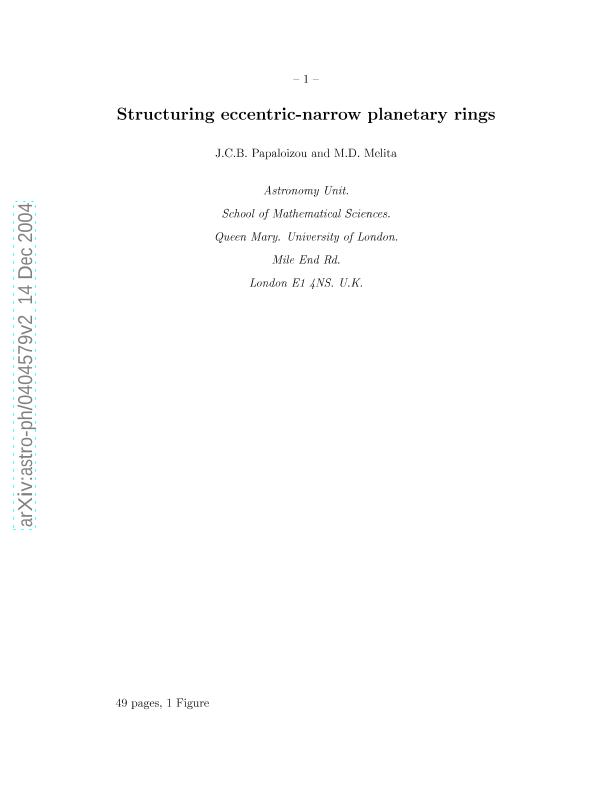Artículo
Structuring eccentric-narrow planetary rings
Fecha de publicación:
12/2005
Editorial:
Elsevier
Revista:
Icarus
ISSN:
0019-1035
Idioma:
Inglés
Tipo de recurso:
Artículo publicado
Clasificación temática:
Resumen
A simple and general description of the dynamics of a narrow-eccentric ring is presented. We view an eccentric ring which precesses uniformly at a slow rate as exhibiting a global m = 1 mode, which can be seen as originating from a standing wave superposed on an axisymmetric background. We adopt a continuum description using the language of fluid dynamics which gives equivalent results for the secular dynamics of thin rings as the well-known description in terms of a set of discrete elliptical streamlines formulated by Goldreich and Tremaine (1979, Astron. J. 84, 1638–1641). We use this to discuss the nonlinear mode interactions that appear in the ring through the excitation of higher m modes because of the coupling of the m = 1 mode with an external satellite potential, showing that they that can lead to the excitation of the m = 1 mode through a feedback process. In addition to the external perturbations by neighboring satellites, our model includes effects due to inelastic inter-particle collisions. Two main conditions for the ring to be able to maintain a steady m = 1 normal mode are obtained. One can be expressed as an integral condition for the normal mode pattern to precess uniformly, which requires the correct balance between the differential precession induced by the oblateness of the central planet, self-gravity and collisional effects is
the continuum form of that obtained from the N streamline model of Goldreich and Tremaine (1979, Astron. J. 84, 1638–1641). The other condition, not before examined in detail, is for the steady maintenance of the nonzero radial action that the ring contains because of its finite normal mode. This requires a balance between injection due to eccentric resonances arising from external satellites and additional collisional damping associated with the presence of the m = 1 mode. We estimate that such a balance can occur in the -ring of Uranus, given its currently observed physical and orbital parameters.
Palabras clave:
Planetary Rings
,
Celestial Mechanics
Archivos asociados
Licencia
Identificadores
Colecciones
Articulos(IAFE)
Articulos de INST.DE ASTRONOMIA Y FISICA DEL ESPACIO(I)
Articulos de INST.DE ASTRONOMIA Y FISICA DEL ESPACIO(I)
Citación
Papaloizou, J. C. B.; Melita, Mario Daniel; Structuring eccentric-narrow planetary rings; Elsevier; Icarus; 175; 2; 12-2005; 435-451
Compartir
Altmétricas




